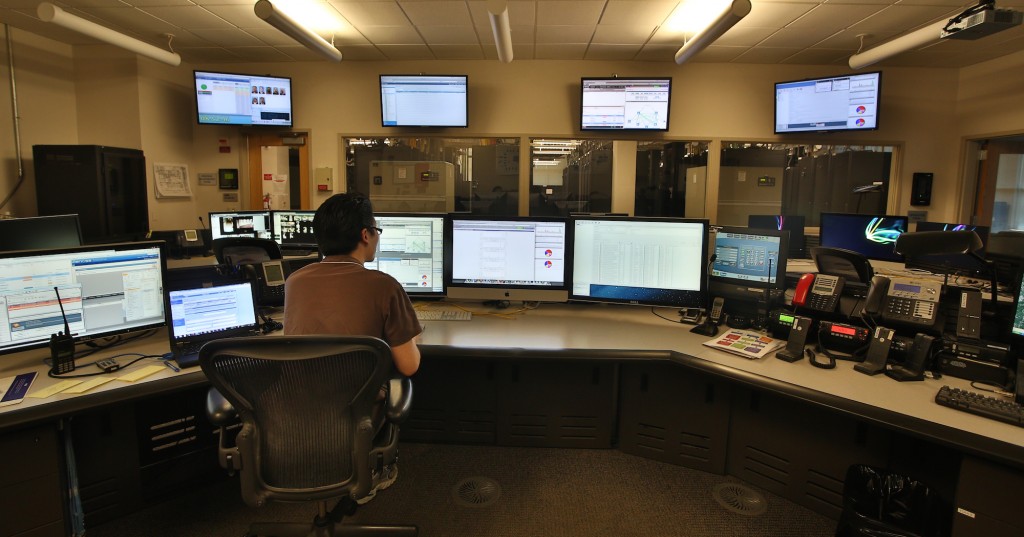On May 30, ITS launched a new system that enables major improvements to communicating when ITS systems and services are not working normally.
The new centralized monitoring platform, Opsview, will soon be fully integrated with ITS’ existing notification platform and status website. Integrating Opsview enables real-time updates to ITS Status, ITS’ public-facing status page.

“This means that you can expect to see any problems with automated services as soon as we know about them with almost no delay,” said Ryan Turner, Head of Networking for ITS Infrastructure & Operations.
Turner also manages the ITS Operations Center, or Ops Center. The Ops Center monitors ITS services and coordinates the response to system outages and degradations. Teams within ITS Infrastructure & Operations are implementing the integration and working with service owners to configure automated monitoring.
To check on the status of a service, users can visit ITS Status directly or use the at-a-glance status overview on ITS’ homepage. ITS may also share major campus IT issues via ITS’ Twitter account.
Real-time updates
“With this new system, any ITS business service being monitored will generate programmatic real-time updates to ITS Status while simultaneously notifying the service owners of the issue,” Turner said.
While most of the new system improvements are to behind-the-scenes workflows, the campus community will notice that updates are posted to ITS Status much more quickly.
For campus users, these real-time updates mean less delay between wondering if there’s an issue and knowing that ITS is working on its resolution.
Proactive and automated
To make real-time updates possible, Opsview uses both proactive monitoring and automated notifications. For proactive monitoring, Opsview uses a process called synthetic monitoring. Synthetic monitoring runs a simulated test on the service at set intervals.
For example, to make sure the ConnectCarolina Student Center is working, Opsview may run automated checks on each step of the process every 15 minutes. Opsview would first check that the ConnectCarolina login page was loading. If that page loads, then it tests Single Sign-On, then ConnectCarolina itself before testing Student Center. All of this testing is hands-off for staff after the system is configured.
If any piece fails, Opsview automatically posts to ITS Status that there is a potential issue. Then, Opsview launches internal workflows so the Ops Center can begin investigating.
Once the Ops Center confirms there is an issue, Opsview enables a workflow that integrates with ITS’ internal notification system and ticketing system. This spins up channels for internal teams to resolve the issue and communicate updates. At each step in the process, Opsview makes it easy for the Ops Center to quickly post updates to ITS Status, keeping campus informed.
This streamlining of operations through automation is a key part of ITS’ commitment to the Carolina Next strategic plan. Specifically, objective 8.1 — to continually improve operations that support the University’s mission.

Committed
“Initially, we will be monitoring services hosted by ITS Networking, which has built out complex business service monitors for most critical functions,” Turner said. This means real-time status updates to campus-critical systems like Wi-Fi.
ITS Infrastructure & Operations will announce when other ITS systems and services are added to the monitoring platform. Adding services takes time, but Turner called Opsview “really user-friendly.”
Turner said that while there may be a few bumps in the road as ITS pilots the new service, ITS is committed to making the new platform work for both IT staff and campus users.
Currently, the platform is only available to ITS. After ITS services are added, Turner said his team will evaluate if the service can be offered to campus.
Ongoing improvements
Turner’s commitment to making the ITS status page more useful and automated is evident in other improvements.
The ITSM Platform Team, also part of ITS Infrastructure & Operations, recently automated another section of ITS Status. In addition to monitoring, ITS Status includes a section for upcoming scheduled maintenance. These posts are now automated, thanks to a new workflow for ITS’ change form. ITS teams use the form internally to propose and approve scheduled maintenance. Previously, the service owner proposing the change would need to send the scheduled maintenance text to the Ops Center. Ops Center staff would then add the scheduled change notice manually.
These scheduled maintenance notifications help IT staff, and potentially users, plan for potential outages or service degradation.
